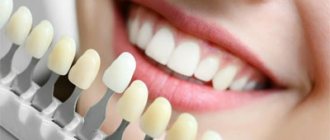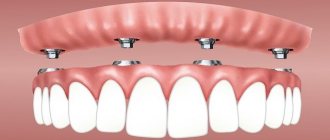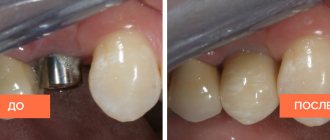Author of the article:
Anastasia Vorontsova
Photo: Computer modeling method
To install veneers, you will need to visit the dental clinic at least twice.
At the first visit, the doctor will prepare the tooth for installation of the onlay, take an impression, select the required color, depending on the color of the patient’s other teeth, and install a temporary veneer.
After one to two weeks, the patient will need a second visit to the dentist, during which the doctor will try on the manufactured veneer and fix it on the tooth.
Scope of application of veneers
Modern dentistry has begun to resort to veneering teeth as an alternative to installing all-ceramic crowns. Making veneers is much simpler, takes less time and costs patients significantly less. Porcelain veneers are created in a laboratory (indirect method) and serve to improve the aesthetics of teeth.
Using veneers you can:
- hide any types of tooth enamel defects:
- fluorosis spots;
- changed color due to treatment with tetracycline;
- darkening of the enamel resulting from dental treatment using old methods or due to injury;
Materials used
Ceramics and filling material are used to make veneers.
There are two types of ceramics - porcelain and zirconium dioxide. Porcelain is very similar to natural tooth enamel; it is highly durable, does not change color even after a long time, and is translucent. Thanks to this, overlays made of this material look very natural and natural, even if you look at them from a close distance. Zirconium dioxide overlays have a long service life and high reliability. They do not absorb food dyes and do not fade over time. Filling material is what veneers, called composite, are made from. They are performed directly in the dental office. As a rule, such dentures are installed on the front teeth without grinding them down.
The cost of composite veneers is lower compared to ceramic ones, but they deteriorate faster and are not able to last a long time.
In addition, there are so-called lumineers - ultra-thin veneers made of very durable porcelain, whose thickness is only 0.2-0.5 millimeters. They do not affect the enamel and can be removed if desired. There is no need to grind down your teeth before installing lumineers; they are secured using a mixture that does not dissolve in saliva.
Advantages of ceramic veneers
Making ceramic veneers is a convenient way to restore a tooth, giving it a natural appearance and eliminating the formation of stains on the surface.
Aesthetic restoration materials traditionally used in dentistry have become stained and discolored over time. This was due to the permeability of the materials, which were vulnerable to the coloring substances contained in some foods and tobacco. Unlike these materials, ceramic veneers have an impenetrable, smooth surface that is resistant to dyes.
Ceramic veneers perfectly imitate natural tooth enamel, the main property of which is transparency. Light rays are not reflected from the surface of natural enamel, but penetrate deep into the opaque tooth tissue and are reflected from it, dissipating. Aesthetic dentistry has traditionally used opaque materials, the surface of which reflects light, which makes the appearance of the dentition unnatural. Porcelain veneers are transparent, due to which the teeth restored by them are ideally similar to natural ones and are in no way different from neighboring teeth.
Methods for making ceramic veneers
There are several methods for making veneers in dentistry. Each of them has its own characteristics and has a number of advantages.
Layer-by-layer method
One of the most common methods for making plates. To create a veneer, platinum foil is used, which tightly compresses the tooth model. Several layers of ceramic are applied to its surface. For uniform application, use a brush. Once the foil is completely covered with the substance, the formed plate is transferred to an oven to fire the material. The peculiarity of this method is that the product used does not spread, and thanks to the firing process, the shrinkage coefficient of microprostheses is reduced.
Pressing method
Using a plaster jaw model, a model of future wax plates is made. At the end of the modeling process, the master attaches the gating system and places the model in a ditch with a refractory substance. Then the vessel is exposed to high temperature, as a result of which the wax that is inside begins to melt and flow out. Under the influence of pressure, liquid material begins to flow into the free sections to create veneers. After it hardens, the surface is covered with the required color. The plates then go through a glazing process. Creating products using this method makes them very durable.
In order for teeth covered with ceramic onlays to look beautiful and not lose their properties for a long time, you should carefully care for them. It is recommended to clean your mouth daily. Don't forget that veneers are not meant for opening bottles, cracking nuts, or biting your nails. This can lead to cracks and chips. If you have the first defects, you should immediately contact your dentist.
Creating veneers: key steps
During the first visit to the clinic, the patient prepares a tooth for veneering, takes an impression, selects the color of the ceramic material to match the rest of the teeth, and installs a temporary veneer. Within one to two weeks, a ceramic veneer is made in the laboratory, which is installed for the patient during the second visit to the clinic.
The veneer of the tooth must be strong, so the veneer is 0.5-0.7 mm thick. To ensure that the restored tooth does not stand out from the row, a layer of enamel must be removed from its surface to the appropriate depth. The tooth is prepared so that the veneer is tightly and securely attached to its surface.
After removing the layer of enamel under the veneer, the dentist takes an impression of the tooth using a special material - usually impression paste. Once the material has hardened, the impression is ready and removed from the tooth. Using individual casts, specialists in the laboratory using the casting method prepare a plaster model - a copy of the tooth to be restored. The veneer made by specialists must fit the model perfectly.
The shade of the cladding is selected using a color chart - a special set of porcelain plates of various shades. This allows you to make a veneer that will not visually differ in color from neighboring teeth.
Making porcelain veneers takes a certain amount of time, usually up to two weeks. To prevent the ground tooth from causing inconvenience to the patient (it may have a sharp edge, react to the temperature of food, etc.), it is covered with a temporary veneer, which the dentist makes himself during the patient’s first visit. In some cases, temporary cladding is not installed for some reason. You should avoid putting stress on the tooth with a temporary veneer - such veneer can easily break or come off.
Before installing a permanent porcelain veneer, the dentist needs to check the tight fit of the facing plate to the ground tooth, evaluate the shape of the veneer, and compare its shade with the color of the teeth in the neighborhood. For this purpose, the finished veneer is applied to the tooth, then removed and, if necessary, adjusted. The adjustment continues until the veneer fits snugly against the tooth.
During the fitting process, it is necessary to check the bite - the tooth with the veneer must fit correctly with the rest of the teeth. A well-fitted veneer is cemented onto the tooth; to do this, the contacting surfaces must first be thoroughly cleaned. Then the enamel is etched using a special gel - as a result, the tooth surface becomes rough, which improves adhesion. Next, a layer of cement is applied to the tooth, on top of which a veneer is installed. The doctor removes excess cement squeezed out when attaching the cladding. After the adhesive has hardened, the veneer is considered fully installed.
Manufacturing and installation
Veneers go through the following stages of manufacturing and installation:
- The initial patient appointment usually includes taking an anamnesis, clarifying complaints, examination, and instrumental examination of the teeth.
- The condition of the gums and plaque is assessed.
- If necessary, X-ray and laboratory tests are performed.
The next step is planning, which involves researching factors such as:
- Gender, age, character of the patient.
- The smile and facial shape are assessed.
- The shape of the line of the gingival margin of the patient’s anterior group of teeth is studied.
- The individual characteristics of the tooth, shape, position, location of contact points, and the direction of the tooth axes are assessed.
- The initial parameters of the restored and intact teeth are measured.
- The size of the veneers is predicted and calculated.
- Demonstration of future restoration on a computer monitor.
Before starting the restoration, it is necessary to carry out professional teeth cleaning and only after that select the color of the veneers being made.
Contraindications for use
The production of veneers is contraindicated if:
- caries is not cured;
- teeth are weakened due to gum disease or another reason;
- the enamel on the tooth is too thin;
- teething has not yet completed;
- the patient has a straight bite;
- The patient has bruxism (grinding or clenching of teeth).
Ceramic veneers are not installed on teeth with caries and when diagnosing periodontal diseases, otherwise the teeth under the veneer will quickly deteriorate. Installation of veneers is possible only after complete recovery from these diseases.
Porcelain veneers require grinding of the tooth, and if the enamel is already severely damaged by caries or has a serious chip, installing a veneer is not recommended - it will weaken the already fragile tooth, which will lead to its complete destruction. These teeth are restored using dental crowns. It is also not recommended to use veneers on teeth with a thin layer of enamel - it will not be enough to provide the necessary strength of the veneer.
The production of veneers is also contraindicated for bruxism: porcelain plates easily break due to excessive load when grinding teeth.
Features of ceramic veneers
Ceramic veneers are one of the most popular dentures. This type of lining has a number of positive aspects. They are installed on the front teeth, but before you decide on this procedure, you should be examined by a doctor, as there are a number of contraindications.
Advantages of ceramic veneers:
- For installation, tooth removal is not required. This allows you to preserve the process of trophism of hard tissues.
- Ceramics is an environmentally friendly material.
- Ceramic products can last more than 10 years.
- Thanks to the light transmission properties, teeth covered with such plates look as natural as possible.
- Products can be installed on cutters.
- With proper care, the material does not lose its shine and does not turn yellow.
Ceramic veneers can be installed on both older and younger people. They are also given to patients who are allergic to other materials. An equally important advantage of ceramic dentures is that if there are defects, they can be easily replaced with new ones. To remove the plate, a laser is used or the cutting method is used with a diamond bur. Veneers can be attached to one tooth or to several at once. The number of products is chosen by the client himself.
Unfortunately, the installation of products cannot be carried out if there are crowns and bulk fillings on the outer part of the tooth. Also, the plates are not intended for attachment to artificial teeth.
Dental care with veneers
The service life of a veneer is more than 10 years, provided proper care and systematic checks by a dentist. Experts recommend:
- Clean your teeth daily using a brush and floss to avoid the occurrence of caries in veneered teeth;
- Avoid excessive force on teeth with veneers - do not bite your nails, do not bite threads, do not crack nuts, etc. Otherwise, it is difficult to avoid the porcelain plate being displaced or broken.
Aesthetic dentistry from the Interdentos dental laboratory provides for the production of ceramic veneers at attractive prices.
How long does it take to make veneers?
The production time for overlays, with quick color selection and no additional problems, averages from 5 to 14 days. The duration of the process is always different, because it depends on:
- material;
- manufacturing method;
- whether the dentistry has its own dental laboratory.
The dentist makes temporary plastic products in no more than an hour. Porcelain veneers are made by a dental technician in a laboratory and the process usually takes about a week. If the design is made using computer modeling, it is often necessary to work remotely. The dentist takes an optical impression of the tooth and transfers the virtual model to the milling workshop. Once the veneer is made, it is sent to the clinic for installation. The entire process may take up to 14 days.











